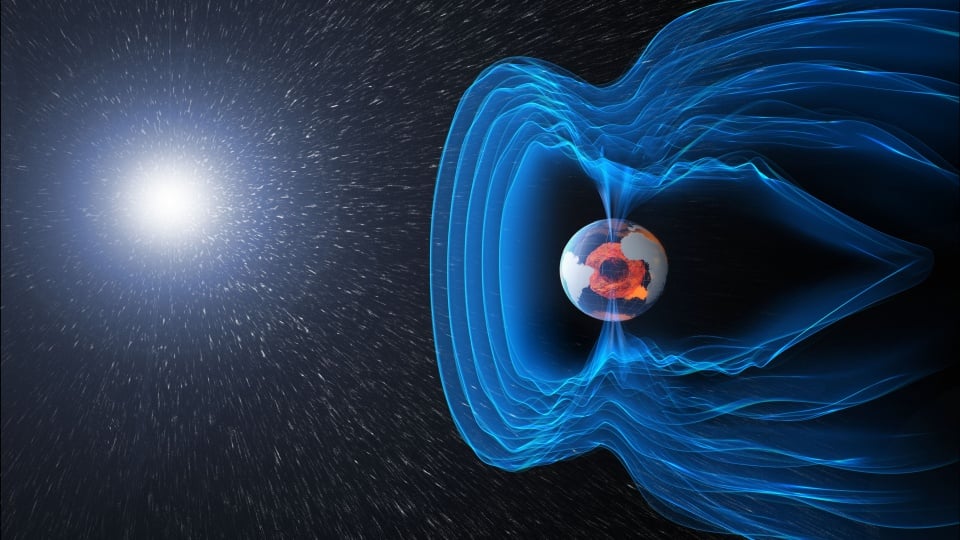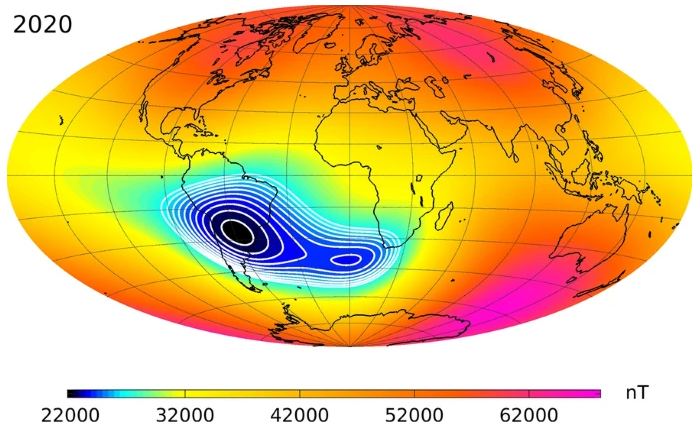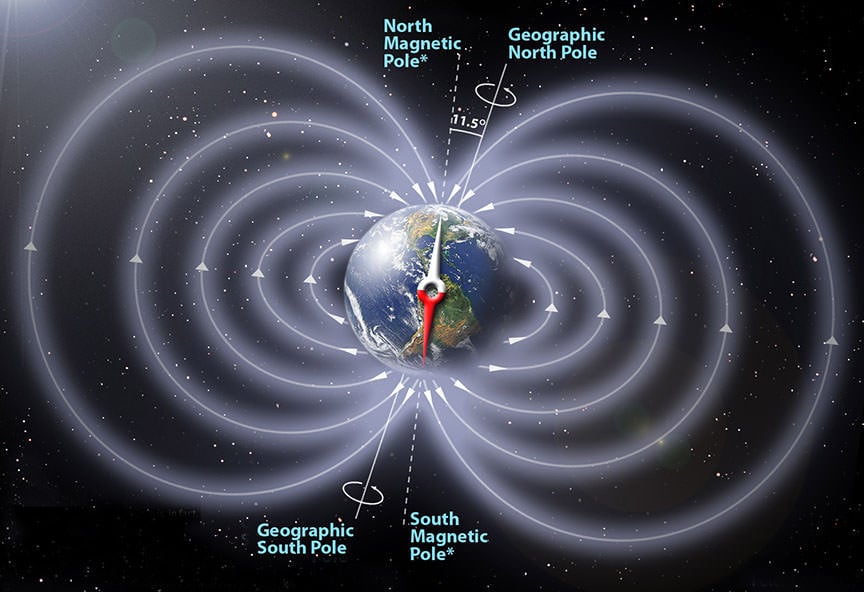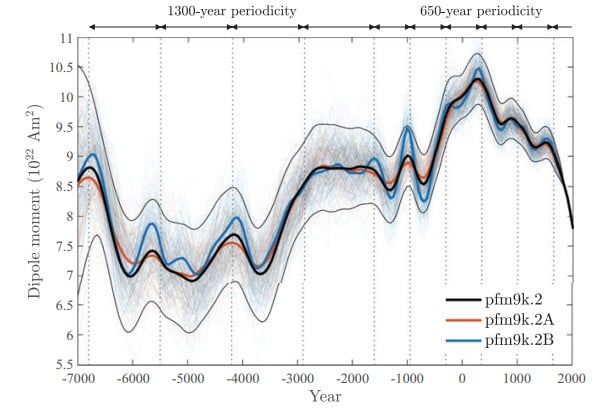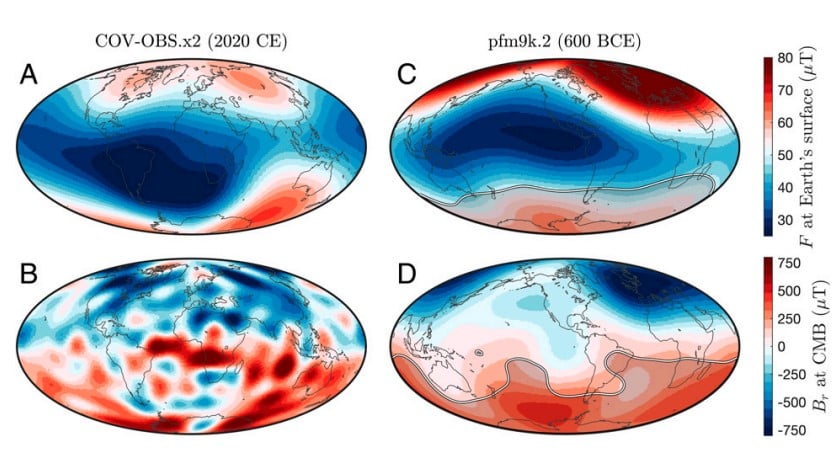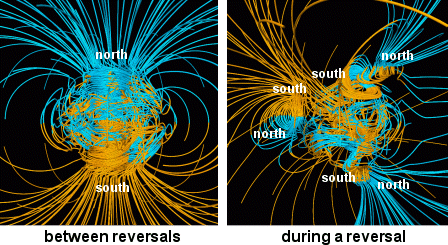One of the most interesting discoveries about Earth in the past few decades concerns the Earth's magnetic poles. Paleomagnetic records show that the poles have flipped places 183 times in the last 83 million years. That's about every 450,000 years on average, though there were ten million years between flips in at least two cases.
The Earth's magnetic field is experiencing some rapid changes right now, but scientists say that has no relation to pole flipping.
When the poles flip, scientists call it a geomagnetic reversal, and the last one happened about 780,000 years ago. It takes between 2,000 and 7,000 years for the poles to reverse. The evidence is contained in magnetic minerals inside rocks. Magnetic minerals record the strength and direction of Earth's magnetic fields when they're locked in place, either as sediments or in magma. The study of magnetism in Earth's ancient rocks is called paleomagnetism.
Currently, there's a region in the South Atlantic where the geomagnetic field is rapidly weakening. It's called the South Atlantic Anomaly (SAA), and it's led to questions about its role in geomagnetic reversal if any.
Scientists have known about the SAA for a while. What they didn't know for sure was if the anomaly signifies an imminent geomagnetic reversal. Researchers behind a new study looked at evidence going back thousands of years to determine if the SAA is heralding an upcoming reversal.
In the past 180 years, the strength of Earth's magnetic field has decreased by about 10 percent. During that same time, the size of the SAA has grown. Scientists have speculated that these events might be related to a geomagnetic reversal.
A new study in the Proceedings of the National Academy of Sciences searched for a link between the SAA, the decreasing field strength, and geomagnetic reversals. It's titled " Recurrent ancient geomagnetic field anomalies shed light on future evolution of the South Atlantic Anomaly." The lead author is Andreas Nilsson, a geologist at Lund University in Sweden.
"We have mapped changes in the Earth's magnetic field over the past 9,000 years, and anomalies like the one in the South Atlantic are probably recurring phenomena linked to corresponding variations in the strength of the Earth's magnetic field," Nilsson said in a press release.
The researchers examined three types of evidence: solidified volcanic samples, sediment drill cores, and burnt archaeological artifacts. Artifacts like clay pots that have been heated above 580 Celsius (1076 F) allow magnetic materials to reorient themselves to the Earth's magnetic field at the time. All three types of evidence act as time capsules that capture a snapshot of Earth's magnetism at a specific time.
"We have developed a new modelling technique that connects these indirect observations from different time periods and locations into one global reconstruction of the magnetic field over the past 9,000 years," said Nilsson.
Earth's magnetic field is a dipole field because it has two poles, like a bar magnet. The dipole moment (DM) measures a field's polarity or separation of positive and negative charges. In this study, the researchers reconstructed Earth's DM for the prior 9,000 years, which makes up the bulk of the Holocene epoch.
But there are difficulties interpreting the paleomagnetic data in sediments, lava, and artifacts during the Holocene.
"The challenges with Holocene geomagnetic field reconstructions are mainly related to the 1) sparse data distribution, 2) chronological data uncertainties, and 3) temporal smoothing due to the gradual process by which sediments acquire a magnetization," the paper states. The model the authors used to deal with these difficulties includes taking advantage of "... the most up-to-date archaeomagnetic data compilation and paleomagnetic directions from 10 sediment records, strategically selected based on data quality and geographic location."
Earth's magnetic field also varies by location, with regions of both stronger and weaker intensity. It can be different on Earth's surface compared to the core-mantle boundary (CMB.) The researchers measured the intensity of the field at the surface and the CMB at 2020 and 650 BCE as part of their overall effort to understand the SAA and geomagnetic reversals.
According to the authors, the SAA doesn't suggest an upcoming reversal of Earth's magnetic poles.
"Based on similarities with the recreated anomalies, we predict that the South Atlantic Anomaly will probably disappear within the next 300 years and that Earth is not heading towards a polarity reversal," said Nilsson.
So the SAA will disappear, and the current state of Earth's geomagnetism doesn't indicate an imminent reversal. But one will come, and when it does, it'll be the first time human civilization will have to deal with one. What will it mean for us and our civilization? What will it mean for Earth's other inhabitants? What causes reversals?
It's not clear what causes geomagnetic reversal. Some research shows that it's a natural consequence of the changing nature of Earth's interior. Laboratory experiments reinforce these spontaneous reversals. Other science suggests that external events can trigger reversals. An impact event could create a reversal, or a continental slab subducting into the mantle could trigger them by disrupting convection.
There's uncertainty about the effects of a reversal. Some scientists have hypothesized that reversals could trigger extinctions. If Earth's magnetic shield weakens enough during a reversal, the increase in solar radiation could have dire consequences for life on Earth. But paleointensity evidence shows that the shield doesn't disappear during a reversal and may not weaken enough to be of much consequence. Overall, the evidence doesn't support a link between reversals and extinctions.
It's uncertain what would happen to our technological civilization during a reversal. When the Sun emits a powerful enough blast of energy at the Earth, it can warp the Earth's magnetosphere and wreak havoc on navigation, electronics, and the power grid. A reversal can take several thousand years; during that time, there's chaos before the poles sort themselves out. At the very least, it would disrupt compass-based navigation.
Many animals use magnetoreception to navigate. Grey whales migrate up and down the west coast of North America and may rely on magnetoreception for help. Solar storms can temporarily warp the magnetosphere, and a 2020 study found a correlation between grey whale beachings and solar storms. Would a geomagnetic reversal be hard on whales and other animals that rely on magnetoreception? It can't be counted out.
Can the South Pole Anomaly provide a clue to what might happen during a geomagnetic reversal?
The SAA is concerning because the weakened magnetic field makes life difficult for satellites. That's because of the way it interacts with the Van Allen Belts. The Van Allen Belts are zones of trapped charged particles that surround Earth, and because of the SAA, the belts are closest to Earth over the SAA. So whenever a satellite orbiting Earth passes over the South Atlantic, it faces a period of increased radiation from the Van Allen Belts. The Hubble doesn't take any observations when it passes through the SAA because of the radiation. NASA also says that computers sometimes crashed when the Space Shuttle passed through the SAA.
At the very least, there's reason to believe a pole flip could force us to adapt in numerous ways. We don't think about it much in daily life, but we live in a geomagnetic environment over which we can't possibly hope to have any influence.
If humanity is still around during the next geomagnetic reversal, we'll be forced to adapt in ways we don't fully understand yet. But humanity has survived this long by adapting.
Maybe we'll be fine.
More:
- Press Release: Earth's magnetic poles not likely to flip: study
- New Research: Recurrent ancient geomagnetic field anomalies shed light on future evolution of the South Atlantic Anomaly
- Universe Today: Scientists in Japan Have Found a Detailed Record of the Earth's Last Magnetic Reversal, 773,000 Years Ago
 Universe Today
Universe Today
